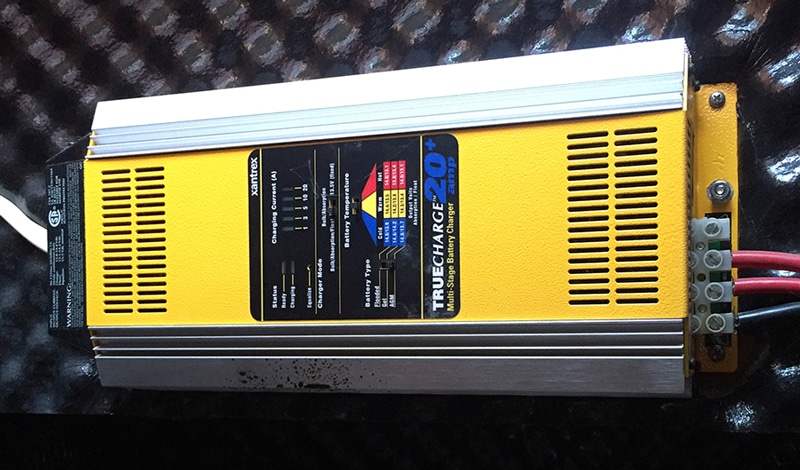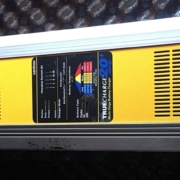Sailboat Battery Charging
Like a water bucket, batteries have a specific storage capacity and must be refilled/recharged when their contents of energy are depleted.
At The Dock
The batteries are typically charged when docked in the marina via the AC shore power. The AC electric distribution panel will more than likely have a switch labeled “Battery Charger.” When on, it will direct the current flow to the battery charger which charges the batteries – automatically.

A Typical Battery Charger
The battery charger converts the AC shore power voltage to DC electricity and pumps it into the batteries. The standard procedure is to keep the charger activated at all times, even when hooked up to shore power. This will ensure that you will always have adequate 12-volt DC power. Modern DC battery chargers are designed to not overcharge your batteries even when left on indefinitely. Check your model to make sure this is the case.
Charging On Board
When away from the dock, the batteries must be charged from onboard devices. Most commonly, the batteries are charged from a device called the alternator, which is connected to the engine crankshaft via rubber belts and pulleys. This is the same as what is on your car. This means the engine must be running for the alternator to produce electricity. The alternator creates electricity in the same manner as the generator (rotating a wire through a magnetic field) except the alternator has a built-in diode. The diode blocks the reverse flow of current so that only DC current flows out of the alternator. This is then pumped into the batteries. For the alternator to be working properly, you should engage the throttle to bring the engine to at least 1500 rpm.
Below, start the engine and observe the batteries top up from the alternator. Note that when the batteries are full, the smart charger detects this and prevents further charging. The green dot represents the current flow and of course is continuous, not discrete balls of green as in our animation.
Alternators convert the energy stored from the diesel you store on board into electrical energy. They are incredibly inefficient. This is mainly because the technology was brought over from the auto industry. A car rarely depletes its battery beyond a few seconds of starting amps and then the car runs for generally much longer than needed to replace that energy. A sailboat turns off its engines at the first opportunity and desires to operate without the engine for as long as possible – all the while consuming energy. Thus for years, alternators have needed a serious makeover on sailboats. New technology is coming including hybrid systems.
Charging Notes
You must be constantly vigilant to keep your batteries charged with whatever form of electric energy is available. In the electrical age, flat batteries on the ocean are a precursor to disaster.
Batteries do not like being constantly cycled from fully drained to fully charged. They typically stay in better health if they are constantly kept full of charge and a solar panel mounted permanently on a cabin top is good at doing this.
Regularly inspect your alternator, and its belt and pulleys, otherwise your only sign of failure will be a flat battery when you are out on the water. To test the alternator, you need to check that it is pumping about 13.5 to 14 volts into the 12-volt battery. Start the engine after the battery has been drained a little. Check the voltage across the terminals of the battery. If the voltage is in the 13.5 to 14-volt range then it is likely that your alternator is functioning properly. If the voltage reads the same as the battery when the engine is off, you may have a problem. Likewise, if the voltage is reading too high around 15 volts, you may also have a problem.
Battery Load Testing
Multimeters are not ideal for testing the health of an automotive or marine battery. For this, you need to use a load tester, which puts a heavy current drain on the battery and analyzes the output. Virtually all automotive stores and marine chandleries have a load tester that will test your battery for free. You can buy a load tester for around $50.






